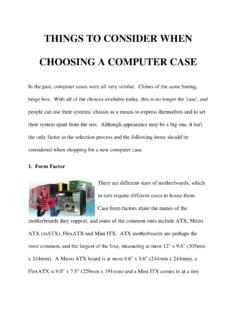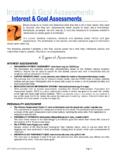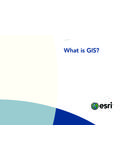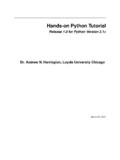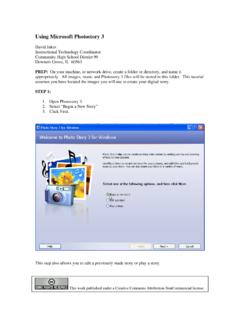Transcription of Example style guide - Technical Editors’ Eyrie
1 Copyright 2002 Jean Hollis WeberPage 1 Example style guideby Jean Hollis WeberThis document accompanies Developing a style guide , published , and includes a sample outline of a style of the sections include some detailed sample text; others do not. Please note that the examplesshown here are not necessarily the correct choices, or the preferred choices, or the best choices;they are simply examples of things to include. Your project may require additional items, especially ifyour writing will be used on a Web guide for XYZ CorporationFollow this style guide when writing or editing materials to be published by XYZ Corporation, to ensurethat documents conform to corporate image and policy, including legal requirements, and to improveconsistency within and among our publications. Use this style guide as part of the specifications foryour writing projects, along with: XYZ Corporation Technical Writing Process guide XYZ Corporation Document Design GuideReferencesThis style guide lists decisions we have made for this company.
2 It supplements several standard styleguides, dictionaries, and other reference material. If you can t find something in our style guide , look inthese references or refer your question to the departmental s Collegiate Dictionary, Tenth Edition. Springfield, MA: Merriam-Webster, Inc., 1994, is thepreferred ManualsThis guide takes precedence over all other Chicago Manual of style , 14th Edition. Chicago, IL: University of Chicago Press, Me First! A style guide for the Computer Industry. Mountain View, CA. Sun Microsystems, Inc. GuidesFor questions about grammar, consult any of the following:Webster s Dictionary of English Usage. Springfield, MA: Merriam-Webster, Inc., , Marjorie E., and Robert M. Gay. Words into Type, 3rd Edition. Englewood Cliffs, NJ: Prentice-Hall, , William, Jr., and White. The Elements of style , 3rd Edition. New York: Macmillan, References[Fill in as appropriate]MechanicsGraphic ElementsInclude drawings, figures, tables, and screen shots, whenever it seems useful or otherwise appropriate.
3 Giveeach graphic element an informative to each graphic element at an appropriate place in the running graphic elements used on Web pages, such as navigation aids, icons, photos, and other images, alwaysinclude alternate text within the IMAGE tags. For standard American punctuation. [If some of your writers are more used to British punctuation, you mayneed to add an Example or two here.]Use of LanguageGeneralUse short, simple, easy-to-understand words and the passive voice, except where appropriate. [You may want to include an Example of an appropriateuse.]In general, use the present tense and, where appropriate, the imperative mood ( Do this. ).Use strong subject-verb constructions. Avoid weak constructions such as There are. Be concise; avoid wordy phrases. Copyright 2002 Jean Hollis WeberPage 2 Use gender-neutral sentence- style capitalization for and spell screen element names to match their appearance on the user interface. To avoidambiguity, capitalize the first letter of each word (including articles, prepositions, and so forth) in the namesof menus, dialog options, commands, fields, and other such elements, regardless of their capitalization onthe user American, not British, spelling; consult the preferred the Terminology section for spelling of computer terms not found in the preferred using a term that includes special leading characters, choose the article that agrees with the way theterm is pronounced.
4 For Example , the term #include is usually pronounced include, so the correct articleis an ( an #include statement ).Units of MeasurementUse American units of (in tables and text)Lists [capitalization and punctuation; treatment of nested lists]TerminologyAbbreviations and AcronymsGenerally Preferred WordsComputer TermsKeyboard Key NamesChoosing and SelectingSpecial CharactersContent of topic types [particularly for online help, but also useful in any situation wheremultiple writers are involved]Overview topicsConceptual topicsReference topicsProblem-solving topicsFrequently-asked question topicsField-level help topicsProcedural ("how to") topicsProcedural topics provide step-by-step instructions on how to complete a user task. User tasks often involvethe use of more than one window or dialog access procedural topics through the index, contents page, or links from window- or topics contain: Task title (briefly identifies and describes the task procedure) Phrased using terms that are familiar to users; users should be able to predict whether the topicmatches their task goals just by reading the title Begins with the gerund form of a verb (ending in ing; for Example , Submitting), followed by anobject Purpose of task or procedure from the user's perspective (a sentence or two that explains the taskpurpose, its usefulness, and the expected outcome or result) Explains, in the users own language, why they would want to perform this task and how itrelates to their work; focuses on user needs, not on how the application works Answers questions like "What user problem does the procedure solve?
5 " and "How does theprocedure fit into the user's work?" Prerequisite conditions or tasks that users must perform before beginning this task If the prerequisite tasks have procedures of their own, link to help topics for those tasks Step-by-step instructions or procedure (numbered steps that describe how to complete the task) Begins with an infinitive tag (a short phrase beginning with "To"; for Example , To submit theform:, To change an emergency contact:). The infinitive explains the purpose of the steps thatfollow. Copyright 2002 Jean Hollis WeberPage 3 Each step describes a single action, such as clicking on a button, selecting an item, choosing amenu item, or typing text in a field. It is written as a verb followed by a noun phrase. If there are multiple ways to complete an action, document a single approach and choose theapproach that users will easily understand and learn. Provide cross-references to other topicsthat describe alternative ways to complete the action, but don't provide cross-references forcommon actions.
6 Procedural topics typically contain about 5 or 6 steps. If a procedure starts to exceed 8 steps,consider breaking it into two procedural topics. What happens now? What happens after a user performs the task steps (outcome; results andfollow up information) Related topics listSample procedural topicTitle of help topicAdding a customerPurposeTo add a customer record:Steps1. Open the Customer Maintenance dialog by clicking a Customerbutton from any Type the relevant details about the customer in the CustomerContact, Customer Address and Account Manager sections. You must fill in the following fields: Customer Name (the full company nameof the customer) Customer Contact section: First Name,Last Name, Phone Customer Address section: StreetNumber, Name, Type, Town, State, PostCodeYou may also fill in any other details in the relevant Save the record by clicking the Save button on the happens now?When you save the record, [product name] automatically assigns theCust ID to the topicsRelated topicsChanging customer recordsDeleting customer records
